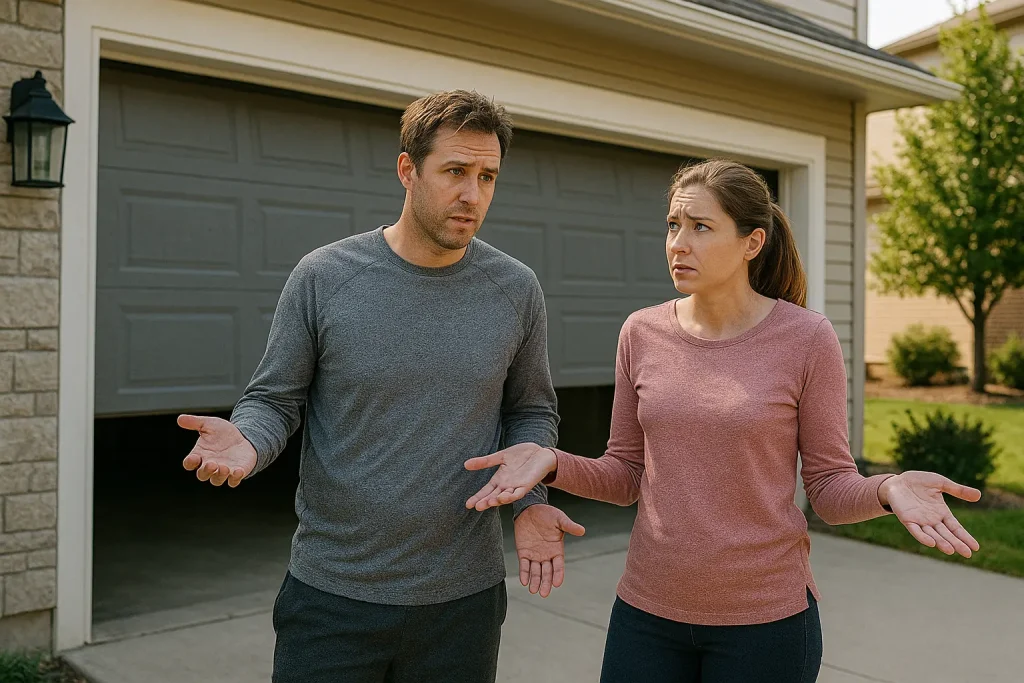A garage door that won’t close properly isn’t just frustrating — it’s a security risk and can interrupt your daily routine. If you’ve ever wondered, “Why won’t my garage door close?” or noticed it gets stuck partway down, you’re not alone.
In this guide, we’ll explain the most common reasons your garage door won’t close, what you can do to troubleshoot it, and when it’s time to call in a professional.
⚠️ Common Reasons Your Garage Door Won’t Close
Let’s break down the most frequent issues and what they mean:
1. 🛑 Safety Sensors Are Blocked or Misaligned
Most modern garage doors are equipped with photo-eye safety sensors positioned a few inches from the floor on each side of the door. These sensors emit an invisible beam between them — and if anything interrupts that beam, the door won’t close.
Symptoms:
- Door begins to close, then immediately reverses
- Flashing lights on the opener unit
- You hear a click but the door won’t budge
Common causes:
- Dust or cobwebs covering the sensor lens
- One or both sensors knocked out of alignment (often by a broom, bicycle, or child’s toy)
- Direct sunlight hitting one of the sensors, disrupting the signal
Fix:
- Clean both sensor lenses with a soft cloth — even light debris can block the beam
- Make sure both sensors are pointed directly at each other (a small LED light should be solid, not blinking)
- If the sensors won’t align or continue blinking, you may need to adjust the mounting brackets slightly or replace a faulty sensor
👉 If your garage door will open but not close, this is one of the most common and fixable causes.
2. 🔋 Remote Battery or Signal Issues
Garage door remotes work via short-range radio signals — and when communication fails, it can seem like the door is malfunctioning when it’s just a control issue.
Symptoms:
- The door responds to the wall button but not the remote
- Inconsistent behavior (e.g., works from inside the garage but not outside)
- Remote lights up but nothing happens
Fix:
- Replace the batteries (even if the indicator light still works — weak batteries can reduce signal strength)
- Reprogram or re-sync the remote to the opener (instructions vary by model, so check your manual)
- Try standing closer to the garage door — nearby Wi-Fi routers, LED lighting, or even metal garage roofs can cause signal interference
👉 If your wall switch works but the remote doesn’t, this is the most likely culprit.
3. ⚙️ Travel Limits or Force Settings Are Incorrect
Garage door openers are calibrated to know when to stop the door’s movement. These are called travel limit and force settings — and if they’re off, your door may not fully close or may reverse at the wrong time.
Symptoms:
- The garage door stops short of the floor
- The door hits the ground, then reverses
- You hear the motor running longer than necessary
Fix:
- Locate the adjustment screws on your opener unit (usually labeled “Up/Down” or “Open/Close”)
- Carefully increase the downward travel incrementally, testing after each adjustment
- If the door hits the ground and reverses, decrease the “close force” slightly
Tip: Refer to the user manual or the manufacturer’s website for safe adjustment procedures. Over-adjusting force settings can be dangerous if it overrides safety features.
👉 A miscalibrated limit setting is a frequent cause when the garage door won’t close all the way.
4. 🪛 Obstructions or Damage to the Tracks and Rollers
Garage doors rely on clean, straight tracks and smooth rollers to open and close properly. If anything blocks the path — or if a track is bent — the door may jam or auto-reverse for safety.
Symptoms:
- Door moves a few inches, then stops or reverses
- Loud screeching, rubbing, or grinding noises
- The door appears tilted or uneven
Fix:
- Inspect both sides of the track for pebbles, leaves, tools, or small objects
- Check for dents or bends in the metal rail that may restrict the rollers
- Lubricate the rollers and hinges with silicone-based garage door lubricant
- If you see warped tracks or rollers popping out of place, contact a technician to avoid worsening the damage
👉 A garage door that won’t close consistently or reverses halfway is often experiencing track alignment problems.
5. 🔐 Manual Lock Is Engaged or Opener Is Disconnected
If your garage door is completely unresponsive or refuses to close with no sound or movement, there’s a chance the manual lock is engaged, or the door has been disconnected from the opener (common during power outages or manual override).
Symptoms:
- Door won’t move at all, but the opener light turns on
- You hear the motor running but the door doesn’t move
- A red cord hanging loose from the opener rail
Fix:
- Check for a manual sliding lock on the inside of the garage door — if engaged, simply slide it open
- Re-engage the garage door opener by pulling the emergency release cord toward the door and manually pushing the door until it reconnects to the opener carriage
- Make sure nothing is jamming the lock mechanism from inside
👉 This is a common issue if the garage door will not close at all, especially after a power loss.
Final Word
If you’re standing there asking, “Why won’t my garage door close?”, don’t panic — many issues are minor and can be resolved without professional help. From dirty sensors and battery issues to travel limits and blocked tracks, each problem has a logical fix.
But if your garage door will open but not close, or it will not close all the way despite troubleshooting, it’s time to call a local expert. Trying to force or repair complex components (like springs or tracks) without training can be dangerous.
👉 Need help fast? Compare trusted local garage door repair pros near you for quick and safe service.

